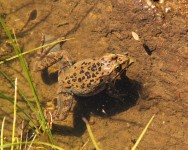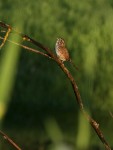Have you taken the time to listen on a warm, summer evening? Trains, trucks and lawn mowers are the first sounds you may hear but if you tune them out you may hear a chorus of clicking, buzzing, chirping and creaking. You probably won’t see who is playing the sounds coming from the grasses, fields, trees and shrubs. As soon as you approach, the musicians–crickets, katydids and cicadas–will stop playing.

Crickets, katydids and cicadas don’t all sing in the evening, some sing during the day and some sing at night. Since they are cold-blooded the insects need to warm up to begin singing, which is why we don’t hear them on cool mornings or cool rainy days.
Like birds, each species has its own “song” but the insects don’t sing using their throats and lungs. Crickets, katydids and cicadas make sounds using specialized parts on their body.
Crickets and katydids make sounds using their wings in a method called stridulation. Where the wings meet are a file and a scraper. On the top wing is a tiny row of teeth (file) and at the base of the bottom wing is a sharp edge (scraper). As the wings close, the scraper rubs across the file making a pulse of sound on each tooth, much like running your fingernail across the teeth of a comb.
The pulses of sound run together to create buzzing, chipping, chirping and clicking. The insects can rub their wings together fast–the common field cricket “plays” 4,000 teeth per second.
An entire meadow of crickets and katydids can produce an impressive chorus because the sounds are amplified. Crickets possess harps and mirrors on their wings that bounce and amplify the sound into the air.
One of the loudest insects in the world is the cicada. Periodic cicadas are well-known for their huge swarms every 13 to 17 years in the eastern United States but the cicadas in Idaho aren’t periodic cicadas.
The loud song produced by cicadas comes from timbals (stiff, flexible ribs) which are located on each side under the wings. To make a sound the cicada lowers its abdomen and puffs it out. Then the cicada uses its timbal muscles to pull in the timbals one at a time which buckle like a squeezed pop can and make a quick sound. Then as the muscles relax, the timbals pop back out just as fast. The sound from each rib buckling and popping out runs together to create a buzzing or ticking sound.
As with birds, the majority of the singing is done by males wanting to attract females. Each female recognizes the song of her species as it is a distinct song.
In general, cricket songs are musical because the frequencies are relatively pure and low. Katydid and cicada songs tend to sound buzzy, raspy or whiny because the frequencies are higher and less pure than crickets.
Another helpful way to tell what insect is singing is where and when the song is heard. Cicadas tend to call during the day and at dusk from trees and shrubs whereas katydids call at night and are not restricted to woody vegetation. Crickets sing day or night from a wide variety of vegetation depending on the species.
As you’re enjoying the warm summer days and nights, take the chance to listen to the insects’ chorus. Not only will the chorus fade away this fall but the sounds will fade away as you lose your ability to hear high frequencies.



